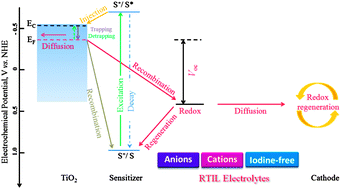Recent molecular engineering of room temperature ionic liquid electrolytes for mesoscopic dye-sensitized solar cells
Abstract
Over the past decade, room temperature ionic liquids (RTILs) have been widely recognized as alternative green, tunable and robust electrolytes for mesoscopic dye-sensitized solar cells (DSCs) due to their unique properties. The negligible volatility of RTILs renders them more suitable than molecular solvents for long-term device use, while the high thermal and electrochemical stability fulfill the essential requirements for electrolyte applications. In spite of the relatively high viscosities of common RTIL iodides, the mass transport limitations can be effectively alleviated by the contribution of a Grotthous-type charge exchange mechanism. More interestingly, the physicochemical properties of RTILs can be facilely tuned by tailoring their cationic and anionic structures, which provides great feasibility for the specific designing of application-oriented RTILs. In this Feature Article, recent progress on highly efficient DSCs with RTIL electrolytes are summarized, with a special focus on the structural-dependence of the ionic diffusion property in RTIL electrolytes, as well as the charge transport and recombination kinetics at RTIL electrolytes/dye molecule/TiO2 electrodes interfaces. Furthermore, recent advances in RTIL electrolytes with iodine-free redox couples have been reviewed. Crucial issues that should be addressed in the pursuit of future developing low-cost and high-efficient RTIL electrolytes are also discussed.


 Please wait while we load your content...
Please wait while we load your content...